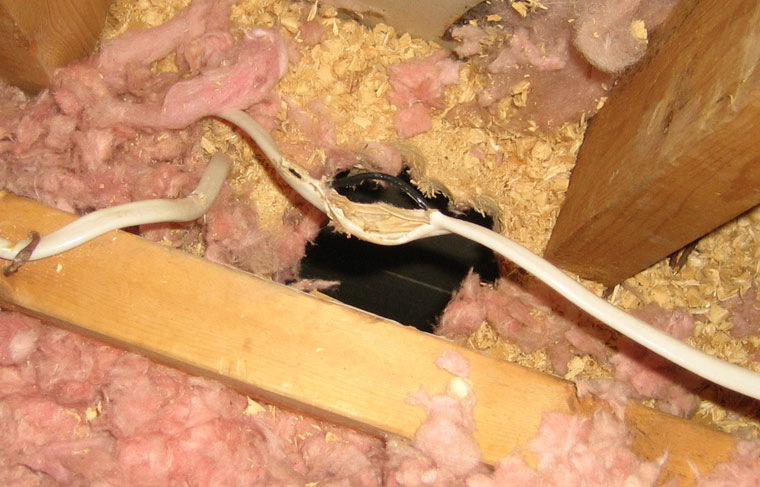- info@wildlife-removal.com
Call us for help in your town
Wildlife Removal Education
Types of Damage Caused By Raccoons in the Attic
Need raccoon removal in your hometown? We service over 500 USA locations! Click here to hire us in your town and check prices - updated for year 2020.
You'll soon know if you have raccoons hanging out in the attic. Look here for my raccoon damage photos. They aren't known for being the quietest animals in the world, so all that thudding, growling, chattering, whimpering, and tearing around inside the depths of your home is going to alert you to their presence before very long. Read about Raccoon in the Attic: The Signs

Noises that could be wild animals up in the attic should definitely not be ignored. Not if you'd rather not put your hands in your pocket to pay out for repair bills, anyway. The longer the problem is left, the more damage and destruction you will be faced with, and this can happen to not just your personal belongings, but also to your actual home. Raccoons are well known for ripping off siding, breaking eaves, smashing their way into chimneys, tearing through window screens, and even opening window and door latches, in some cases.
They're smart animals, to say the least.
Knowing what to look for when it comes to raccoon damage and destruction is important if you live in an area where wildlife interactions are high. It often starts from the outside — your back yard — which makes life a bit easier for you. Holes in the lawn could be a sign that the raccoon has been digging for insects, especially after a good rainy spell. A knocked over garbage can is usually a pretty good indication that you have furry visitors too, especially if the leftovers appear to have been dragged out of it and then devoured.
Raccoons can eat plant life in the back garden, especially if you have fruits or vegetables growing, and even some flowers, shrubs, and trees aren't safe. Ponds with fish, toads, and other life are likely to come under attack, and the same can be said for bird feeders too — filled with delicious seeds and nuts that the raccoon will enjoy as a tasty snack just as much as the birds will.
You might even see damage to your actual property too. Raccoons are 10/10 determined when they have an idea in their head. What makes life all the more difficult when it comes to predicting their next move is that they aren't just driven by breeding and feeding like other animals; they also have a morbid sense of curiosity, which always gets them into trouble (sometimes fatally), also making them utterly impossible to predict.
There are hundreds of ways that a raccoon could gain access to your attic, once they've managed to get up on the roof. You may find that roofing shingles have been torn away entirely, or cracks in brickwork between the roof and the chimney/the walls and the roof. Siding might be ripped away or broken. Read my full how to get raccoons out of the attic guide.
Once the animal is inside your attic, life doesn't get any better. They will then leave waste matter (urine and feces) everywhere, although, will usually have semi-contained bathroom areas, often referred to as latrines.
Holes that the raccoon used to get inside your home will probably start letting water in, and this will lead to damage or your actual possessions, as well as rotting wood, water dripping through the roof into the main frame of the building, and mould. After a while, other wildlife species will join the party, lured in by the mess that raccoons leave in their wake. A combination of all of these things will create a number of disease threats, but the animal waste by itself is enough to be harmful to both human and animal health and welfare.
Damage caused by raccoons in attic can run into the thousands of dollars to repair if you do not evict these wild critters as soon as you learn of their existence. Leaks can soon become full-time floods, and this will have repercussions on all levels of your home. Water will run down — if there is a leak in your attic, it will only be a matter of time before structures, including ceilings, floors, and walls, become unstable because of undiagnosed and treated water damage.
Whether you've seen the signs, learned of the damage, or heard the animals having a good roll around in your home, make sure that you take action. Ignoring this problem will not make it go away, although, the raccoons may just move on to a new nest site in their own time. Sadly, this just leaves the spot open for that same animal to come back, as well as other raccoons and perhaps other animals too, including rodents.
Go back to the Raccoon Removal page, or learn tips to do it yourself with my How to Get Rid of Raccoons guide.


















